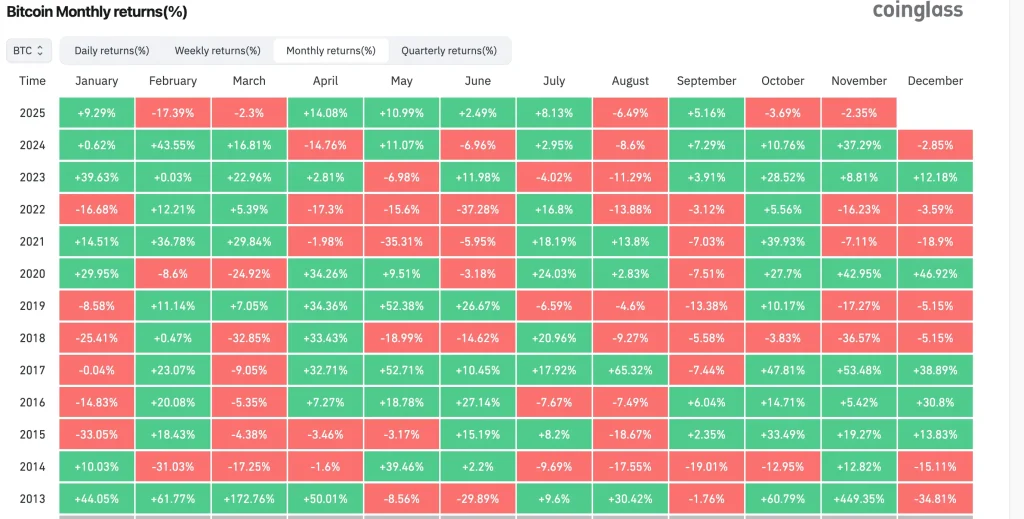- Crypto market sheds $100 billion, dragging majors like Ether, Solana, and XRP down 6–10%.
- Bitcoin slips under $105,000, extending weakness after its worst October in a decade.
- The Federal Reserve’s cautious tone has fueled broad risk aversion across markets.
- Despite the pullback, analysts say Bitcoin could still shape up for a stronger November if support levels hold.
Altcoins Tumble as Bitcoin Struggles Into November
The crypto market began November on shaky ground, with several leading altcoins posting sharp declines. Ether dropped roughly 6%, Solana plunged 10% to under $160, and XRP fell another 5%, deepening last week’s correction. The broader downturn wiped out an additional $100 billion from the global crypto market cap, now hovering near $3.6 trillion.
Bitcoin didn’t escape the turbulence either. After closing out its weakest October in ten years, BTC slid below $105,000 early Tuesday, losing around 2.8% over the past 24 hours. The pressure came as selling intensified across major tokens, reflecting a cautious mood that’s been building since last week’s Federal Reserve meeting.
BNB, DOGE, and Cardano also joined the decline, each shedding roughly 6% as leveraged long positions unwound across thin weekend order books — a perfect recipe for exaggerated downward swings. More than $1.2 billion in liquidations hit the market in just the last two days, pushing traders into a defensive posture as funding rates reset to more neutral territory.
Fed Caution, Liquidity Moves, and Why Bitcoin’s November Still Holds Promise
Much of the recent weakness stems from the Federal Reserve’s latest policy tone. While policymakers delivered their expected 25 bps rate cut, Chair Jerome Powell signaled that a follow-up cut in December isn’t guaranteed. His restrained messaging chilled risk appetite across equities, commodities, and digital assets alike.
The impact was almost immediate. Bitcoin’s long-running “Uptober” streak came to an abrupt end with a 4.5% decline — the first negative October in seven years. The return of macro caution caught traders off guard, especially those expecting a stronger seasonal push.
Still, despite the turbulence, some analysts see reasons for optimism.
Bitcoin is repeatedly retesting its 200-day moving average, a level that often acts as a battleground between bears and long-term buyers. Alex Kuptsikevich of FxPro noted that BTC’s current structure resembles April’s price action — a period that eventually led to a notable upside breakout. If that pattern repeats, buyers could be preparing to step in again.
Rachel Lin, CEO of SynFutures, echoed a similar view. October’s decline, she argued, looks more like consolidation within a broader uptrend rather than the start of a deeper reversal. Long-term holders continue to accumulate, and ETF inflows — a key gauge of institutional participation — remain steady.
Adding another layer, the Fed conducted a $29.4 billion repo operation on Monday, its largest since 2020. While not a return to full-scale quantitative easing, the liquidity injection eased some of the strain in short-term markets and helped stabilize risk sentiment. Treasury yields steadied afterward, and equities saw lighter selling as investors processed the signal.
Historically, November has been a strong month for Bitcoin, posting gains in nine of the past twelve years. Whether that streak continues will depend on how quickly confidence returns — and whether the Fed’s “soft pivot” narrative actually brings capital back into risk assets.
Gold, which recently touched record highs near $4,400, has also pulled back as investors reassess their defensive positioning. Futures tied to the S&P 500 traded lower on Tuesday, mirroring the crypto market’s cautious tone.
For now, Bitcoin’s November outlook remains a balancing act between macro uncertainty and the potential for seasonal strength. A clean bounce from its current support zone could reset sentiment — but traders know November has a history of being generous only when momentum is already building.
